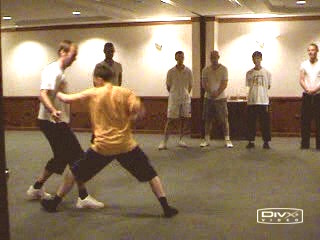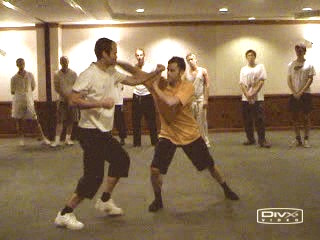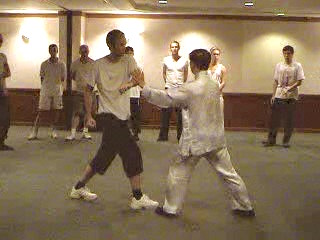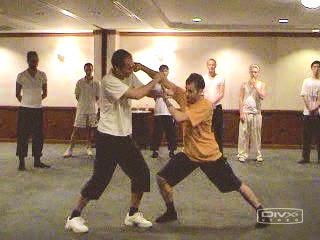EXPLOITING ADVANTAGE TO CLINCH VICTORY
 Capitalizing on an advantage, Padraig presses in with continuous attacks to defeat his opponent
Capitalizing on an advantage, Padraig presses in with continuous attacks to defeat his opponent
In combat, when an opportunity arises you exploit it not just to hit your opponent once and then start all over again, but use it to initiate a series of concerted attacks to defeat your opponent. In kungfu terminology, this is known as “tak sai bat yiew jen” (Cantonese pronunciation). Literally it means “gaining advantageous situation, you do not let your opponent escape”, but figuratively it means that when an opportunity arises you exploit it to clinch victory.
In today's relatively low level of sparring, many martial artists give advantages away freely to their opponents without the opponents having to do anything. This is what we call “free offers”. Not only the opponents fail to exploit these free offers, they are not even aware of them. Sometimes they are aware, but as they are neither prepared nor trained to exploit the advantages, they merely watch them slip away. This is known in kungfu terminology as “sau bat joong sam”, literally “hands fail to follow heart”, which means they fail to execute techniques that they intend to do.
Indeed the typical manner some martial artists move in to attack often gives away these advantages. For example, when a Karate exponent moves in openly to strike, a Taekwondo exponent initiates with a high kick, or a Judo exponent grasps an opponent's collar to throw him, a skillful kungfu exponent could exploit their momentary exposure to defeat them.
Except for their lower body, a Boxer is less exposed. He is also relatively quicker to recover himself when an opponent attacks his exposed weakness. In other words, if all other things were equal, a Boxer is less likely than martial artists of other styles to give you advantages to exploit. If he does not give you an advantage as a free offer, you would have to create it.
An effective way you may create an advantage is when a Boxer initiates an attack. You may intercept his jabs and open his gate, or you may let his jabs pass then close him. Immediately you initiate a series of concerted attacks to defeat him. If he attempts to bounce away, which he frequently does, you can close in with one or two long steps. There are some good examples in the video clips showing such tactics.
 Intercepting a Boxer's Attacks
Intercepting a Boxer's Attacks
James poses as a Boxer to attack Padraig. Padraig uses a good poise, Double Dragon Hands, against the Boxer. At an appropriate point, he intercepts the Boxer and counter-attacks.
Grandmaster Wong gives an analysis of Padraig's techniques, showing how Padraig can intercept and counter-attack more effectively.
Besides pointing out the good points and weaknesses of certain hand techniques, Grandmaster Wong also explains effective use of spacing. If Padraig's intention is to intercept and counter-attack a Boxer, he should not move back, because doing so would negate his advantage.
As a Boxer attacks, you can intercept his attack, open his “gate”, and strike him. But if you move away, you would have missed this tactical advantage.
 Not Necessary to Meet Force Head-On
Not Necessary to Meet Force Head-On
You will need some force to intercept a Boxer's attacks, such as hooks. If you are not forceful enough, you need not meet his attacks head-on but let them pass and close them following their momentum.
 Ensuring Safety Before Attacking
Ensuring Safety Before Attacking
There are some weaknesses in Padraig's counter-attacks. Padraig has not covered himself safely, thus giving the Boxer some opportunities to strike back. Some martial artists often disregard their own safety in attacking.
 Avoiding Weaknesses when Defending against a Boxer
Avoiding Weaknesses when Defending against a Boxer
Here are two more weaknesses in Padraig's defence. Firstly, his defending arm is too high, thus exposing himself. Secondly, he should not move away when deflecting the Boxer's attack, as doing so would negate the advantage gained from that defence.
Padraig's defence against the Boxer's first jab is good, but his defence against the second jab is a weakness. Instead of deflecting and controlling the Boxer's attacking arm, the kungfu exponent can chop at the Boxer's wrist.
Blocking a Boxer's hooks is not correct. It is intercepting, i.e. chopping the Boxer's wrist with your palm. Then you may follow with a snap kick or a knee strike to his groin.
 Clinch Victory when the Opportunity Arises
Clinch Victory when the Opportunity Arises
Don't stop after your first hit. Exploit your advantageous position and continue striking him. This is known in kungfu terms as “tak sai pat yiew jen” (Cantonese pronunciation), which means “clinch victory when the opportunity arises”.
 Bringing Combat Ability to a Higher Level
Bringing Combat Ability to a Higher Level
Padraig learns fast; he implements Grandmaster Wong's advice to defeat an opponent when the opportunity arises. By following just this advice, Padraig has brought his combat ability to a higher level. In today's free sparring or real fighting it is not uncommon to fond many inexperienced fighters miss opportunities where they could have defeated their opponents
 Exploiting an Advantage to Defeat an Opponent
Exploiting an Advantage to Defeat an Opponent
It is not necessary to change steps if it does not give an added advantage. Padraig could further exploit his advantage to defeat his opponent, bring his combat ability to a higher level.
 Respond Spontaneously According to Opponent's Movements
Respond Spontaneously According to Opponent's Movements
Grandmaster Wong goes over the points just mentioned. He opens the opponent's gate and strikes him frontally. Or he may close the opponent's hands and strikes him from a side. A well trained exponent responds spontaneously according to his opponent's movements.
Exploiting Advantages to Clinch Victory in Shaolin Kungfu from Wong Kiew Kit on Vimeo.
1. Stances: the Foundation for Internal Force and Combat Efficiency
2. Footwork Secrets for Health, Efficiency and Elegance
3. Moving into a Same Direction using Different Ways to Gain Advantages
4. Picture-Perfect Forms and Flowing Movements
5. From Random Fighting to Patterns, and from Patterns to Sequences and Sets
6. One-Step Sparring to Develop Combat Skills
7. From Pre-Arranged Sparring to Guided Sparring
8. Using Techniques and Tactics in Sparring
9. The Five Basic Kicks
10. The Secrets of Side Kicks and Continuous Cannons
11. How You may Defeat Opponents Experienced in Random Free Sparring
12. How Would a Fragile Girl Counter a Powerful Sweeping Kick from a Muay Thai Fighter?
13. Shaolin Felling Techniques and their Defences
14. Safety First Before Executing Felling Techniques
15. From Combat Sequences to Free Sparring
16. Sixteen Combat Sequences and Five Kungfu Sets
17. Surprise your Attacker with a Counter-Attack
18. Working out Ways to Fight a Boxer
19. Effective Tactics and Techniques against Boxers
20. From Gross Outline to Fine Details
21. Exploiting Advantage to Clinch Victory
22. Variety of Kungfu Techniques against Boxers
23. Analysis of Techniques Used against Boxers
24. Using Shaolin Kunfu against Boxing in Free Sparring
25. Effective Shaolin Tactics and Techniques against Kick-Boxing
26. Shaolin Kungfu against Kick-Boxing in Free Sparring
27. How to Handle a Karate Exponent
28. How to Handle a Taekwondo Exponent
29. How to Handle a Wrestling Exponent
30. Understanding the Typical Attacks of Muay Thai Fighters
31. Grandmaster Ho's Secrets in Countering Muay Thai Fighters
32. First Avoid Defeat, Then Secure Victory
33. Counteroing the Elbow and Knee Attacks of Muay Thai Fighters





